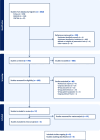Lower pregnancy rate in women with high uterine peristalsis before embryo transfer: a systematic review and meta-analysis
- PMID: 40158105
- PMCID: PMC11954245
- DOI: 10.1186/s12958-025-01380-5
Lower pregnancy rate in women with high uterine peristalsis before embryo transfer: a systematic review and meta-analysis
Abstract
Background: Uterine contractions, also known as peristalsis, have been shown to affect fertility. However, despite previous studies, most clinicians have not paid sufficient attention to uterine peristalsis. Recent studies have recognised its importance and evaluated contractility parameters prior to embryo transfer.
Method: A systematic literature search was conducted in Medline, Embase and Cochrane CENTRAL up to January 2024. Inclusion criteria were studies involving patients undergoing in vitro fertilization (IVF) or other infertility treatments in which uterine contractility was assessed. Studies were excluded if they included therapeutic interventions that affected contractility, or if they focused on uterine pathologies such as adenomyosis or fibroids. The meta-analysis included trials with IVF treatments that compared clinical pregnancy rates in women with high versus low frequent uterine contractions.
Results: A total of 2587 women (17 studies) were included in the systematic review, of whom 1134 (43.1%) (5 studies) underwent embryo transfer and were eligible for meta-analysis. The review found that elevated contractility on the day of embryo transfer is associated with a negative impact on pregnancy rates. The meta-analysis showed that women with two or more uterine contractions at the time of the embryo transfer had a significantly lower clinical pregnancy rate than with women with two or fewer contractions (OR 0.52, 95% CI: 0.38- 0.69). There was moderate heterogeneity between studies (I2 = 55, p < 0.01).
Conclusions: The lower clinical pregnancy rate in women with high uterine contractility, highlights the role of uterine peristalsis around the time of embryo implantation. However, due to the limited and heterogeneous data available, the influence of uterine peristalsis on reproductive outcomes such as live birth rates remains unclear.
Keywords: Embryo transfer; Implantation rate; Pregnancy rate; Uterine contractility; Uterine peristalsis.
© 2025. The Author(s).
Conflict of interest statement
Declarations. Ethics approval and consent to participate: Not applicable. Consent for publication: Not applicable. Competing interests: The authors declare no competing interests.
Figures


Similar articles
-
Day three versus day two embryo transfer following in vitro fertilization or intracytoplasmic sperm injection.Cochrane Database Syst Rev. 2016 Dec 14;12(12):CD004378. doi: 10.1002/14651858.CD004378.pub3. Cochrane Database Syst Rev. 2016. PMID: 27976360 Free PMC article.
-
Cleavage-stage versus blastocyst-stage embryo transfer in assisted reproductive technology.Cochrane Database Syst Rev. 2022 May 19;5(5):CD002118. doi: 10.1002/14651858.CD002118.pub6. Cochrane Database Syst Rev. 2022. PMID: 35588094 Free PMC article.
-
Application of seminal plasma to female genital tract prior to embryo transfer in assisted reproductive technology cycles (IVF, ICSI and frozen embryo transfer).Cochrane Database Syst Rev. 2018 Feb 28;2(2):CD011809. doi: 10.1002/14651858.CD011809.pub2. Cochrane Database Syst Rev. 2018. PMID: 29489026 Free PMC article.
-
Post-embryo transfer interventions for assisted reproduction technology cycles.Cochrane Database Syst Rev. 2014 Aug 27;2014(8):CD006567. doi: 10.1002/14651858.CD006567.pub3. Cochrane Database Syst Rev. 2014. PMID: 25157849 Free PMC article.
-
Individualised gonadotropin dose selection using markers of ovarian reserve for women undergoing in vitro fertilisation plus intracytoplasmic sperm injection (IVF/ICSI).Cochrane Database Syst Rev. 2018 Feb 1;2(2):CD012693. doi: 10.1002/14651858.CD012693.pub2. Cochrane Database Syst Rev. 2018. Update in: Cochrane Database Syst Rev. 2024 Jan 4;1:CD012693. doi: 10.1002/14651858.CD012693.pub3. PMID: 29388198 Free PMC article. Updated.
Cited by
-
High Risk of Chronic Endometritis in Isthmocele-A Systematic Review and Meta-Analysis.J Clin Med. 2025 May 22;14(11):3628. doi: 10.3390/jcm14113628. J Clin Med. 2025. PMID: 40507391 Free PMC article. Review.
-
Tubal Ectopic Pregnancy: From Diagnosis to Treatment.Biomedicines. 2025 Jun 13;13(6):1465. doi: 10.3390/biomedicines13061465. Biomedicines. 2025. PMID: 40564186 Free PMC article. Review.
References
-
- Ashary N, Tiwari A, Modi D. Embryo Implantation: War in Times of Love. Endocrinology. 2018;159:1188–98. - PubMed
-
- Martinez-Gaudio M, Yoshida T, Bengtsson LP. Propagated and nonpropagated myometrial contractions in normal menstrual cycles. Am J Obstet Gynecol. 1973 [cited 2024 May 12];115:107–11. Available from: https://linkinghub.elsevier.com/retrieve/pii/0002937873900963 - PubMed
-
- Fanchin R, Ayoubi JM. Uterine dynamics: impact on the human reproduction process. Reprod Biomed Online. 2009;18(Suppl 2):57–62. - PubMed
Publication types
MeSH terms
LinkOut - more resources
Full Text Sources

